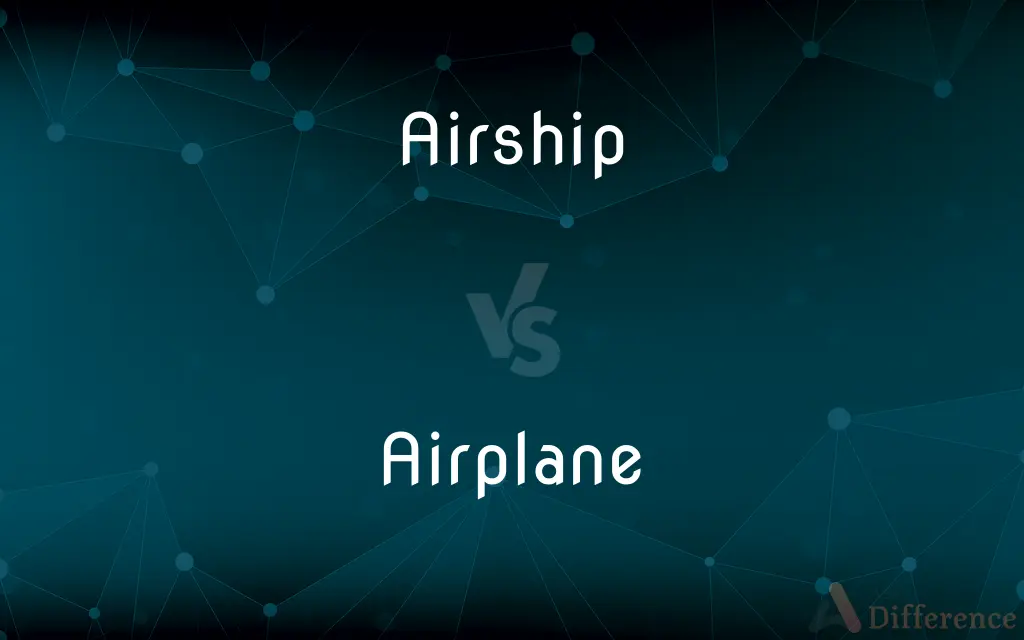Airship vs. Airplane — What's the Difference?
Edited by Tayyaba Rehman — By Fiza Rafique — Updated on April 26, 2024
Airships rely on buoyancy for lift, utilizing lighter-than-air gases like helium, while airplanes generate lift through fixed wings and forward motion.

Difference Between Airship and Airplane
Table of Contents
ADVERTISEMENT
Key Differences
Airships, often known as blimps or dirigibles, use buoyant gases such as helium to lift off the ground and remain airborne; these gases are less dense than the surrounding air. Whereas airplanes achieve lift through the aerodynamic design of their wings, which forces air downward and the plane upward as it moves forward.
Airships typically travel at slower speeds and can hover and maneuver at low speeds, making them ideal for observational purposes. On the other hand, airplanes are designed for faster travel, efficiently covering long distances in short periods due to their powerful engines and streamlined shapes.
The structure of an airship includes a large envelope containing the buoyant gas, which dominates its appearance and provides the necessary lift. In contrast, airplanes consist of a rigid fuselage with wings attached, designed for structural integrity at high speeds and altitudes.
Operational use of airships is often for advertising, surveillance, and tourism, exploiting their stable and slow-moving nature. Whereas airplanes are primarily used for passenger and cargo transportation, taking advantage of their speed and range to efficiently connect distant locations.
Airships handle adverse weather conditions poorly, often being grounded in high winds or storms due to their large, unwieldy shapes. Airplanes, however, are built to withstand a wider range of weather conditions, allowing them to operate in more varied and challenging environments.
ADVERTISEMENT
Comparison Chart
Lift Mechanism
Buoyant gases (e.g., helium)
Aerodynamic lift from wings
Speed
Slow, capable of hovering
Fast, cannot hover
Structural Design
Large envelope containing gas
Rigid fuselage with attached wings
Typical Uses
Advertising, surveillance, tourism
Passenger and cargo transport
Weather Adaptability
Poor, affected by wind and storms
Good, designed to endure varied conditions
Compare with Definitions
Airship
A lighter-than-air aircraft that can be steered.
The airship floated above the city, providing a perfect platform for aerial photography.
Airplane
A propeller-driven airplane, typically used for shorter, regional flights.
The small propeller airplane took off from the rural airstrip.
Airship
A dirigible used historically for transatlantic flights.
The history museum displayed models of early airships used in the 1920s.
Airplane
A fixed-wing aircraft powered by one or more engines.
The airplane soared into the sky, beginning its journey across the ocean.
Airship
A non-rigid type of airship is known as a blimp.
We watched the blimp drift lazily over the stadium.
Airplane
A military airplane designed for combat.
The military airplane displayed impressive maneuvers during the air show.
Airship
A vehicle for aerial advertising with a large envelope for gas.
The airship carried the soft drink company's logo across the sky during the sports event.
Airplane
A jet airplane, known for its speed and long-range capabilities.
The jet airplane reduced the travel time between continents significantly.
Airship
A historical military airship used for reconnaissance.
Airships were once vital for naval scouting before being replaced by faster aircraft.
Airplane
A commercial airliner, used for transporting passengers and goods.
The airliner was almost at full capacity on the eve of the holiday.
Airship
An airship or dirigible balloon is a type of aerostat or lighter-than-air aircraft that can navigate through the air under its own power. Aerostats gain their lift from a lifting gas that is less dense than the surrounding air.
Airplane
(intransitive) To fly in an aeroplane.
Airship
A self-propelled lighter-than-air craft with directional control surfaces. Also called dirigible.
Airplane
An airplane or aeroplane (informally plane) is a fixed-wing aircraft that is propelled forward by thrust from a jet engine, propeller, or rocket engine. Airplanes come in a variety of sizes, shapes, and wing configurations.
Airship
(aviation) A lighter-than-air aircraft that can be propelled forward through the air as well as steered.
Airplane
A powered flying vehicle with fixed wings and a weight greater than that of the air it displaces; an aeroplane.
Airship
A police air unit, a police helicopter
Airplane
Any of various winged vehicles capable of flight, generally heavier than air and driven by jet engines or propellers.
Airship
Any aircraft.
On weekends, I liked to spend my time at the airport watching the various airships take off and land.
Airplane
A powered heavier-than-air aircraft with fixed wings.
Airship
A high ranking official of the RAF, viewed as arrogant and distant.
Airplane
(transitive) To transport by aeroplane.
Airship
To transport goods by aircraft.
Airplane
A heavier-than-air aircraft. Same as aeroplane{2}.
Airship
A steerable self-propelled light-than-air aircraft.
Airplane
An aircraft that has a fixed wing and is powered by propellers or jets;
The flight was delayed due to trouble with the airplane
Airship
A steerable self-propelled airship
Common Curiosities
How do airplanes generate lift?
Airplanes generate lift through the aerodynamic design of their wings.
What type of gas do airships use for lift?
Airships use helium for lift, as it is lighter than air and non-flammable.
What speeds do airplanes typically travel at?
Airplanes usually travel at speeds between 500 and 600 mph.
Can airships hover in one place?
Yes, airships can hover and maneuver at low speeds due to their buoyant lift.
Can airships fly in bad weather?
Airships generally do not perform well in adverse weather and are often grounded.
What are common uses for airships today?
Airships are commonly used for advertising, surveillance, and tourism.
How has airplane design improved over the years?
Airplane designs have improved in aerodynamics, fuel efficiency, and passenger comfort.
What are the main uses of airplanes?
The main uses of airplanes are for passenger and cargo transportation.
Do both airships and airplanes use engines?
Yes, both use engines, but airships use them for propulsion and maneuvering, not lift.
What advancements have been made in airship technology?
Modern airships are more maneuverable and efficient, often equipped with better safety features.
How are airplanes and airships structurally different?
Airships have a large gas-filled envelope, while airplanes have a rigid fuselage with wings.
Are airships safer than airplanes?
Airships have a lower speed and altitude, which can be safer, but they are more susceptible to weather conditions.
What type of flights are propeller airplanes used for?
Propeller airplanes are often used for regional or shorter flights.
What is the historical significance of airships in aviation?
Airships were significant in early aviation for their ability to carry large loads and travel long distances before the advent of advanced airplanes.
What materials are used in the construction of an airplane?
Airplanes are usually made from aluminum, composites, and other lightweight materials.
Share Your Discovery

Previous Comparison
Solicit vs. Canvass
Next Comparison
Mandrill vs. DrillAuthor Spotlight
Written by
Fiza RafiqueFiza Rafique is a skilled content writer at AskDifference.com, where she meticulously refines and enhances written pieces. Drawing from her vast editorial expertise, Fiza ensures clarity, accuracy, and precision in every article. Passionate about language, she continually seeks to elevate the quality of content for readers worldwide.
Edited by
Tayyaba RehmanTayyaba Rehman is a distinguished writer, currently serving as a primary contributor to askdifference.com. As a researcher in semantics and etymology, Tayyaba's passion for the complexity of languages and their distinctions has found a perfect home on the platform. Tayyaba delves into the intricacies of language, distinguishing between commonly confused words and phrases, thereby providing clarity for readers worldwide.
















































